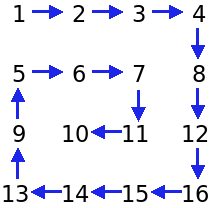 Homer Simpson, ever the lover of donuts and comfort, finds himself in an unusual situation at work. Mr. Burns, inspired by one of his bizarre ideas, has ordered Homer to organize the Springfield Nuclear Power Plant's inventory data in a "spiral path". Homer has no clue what that means, but he does know one thing: if he doesn’t figure it out, there might be trouble (and no donuts for a week!).
Homer Simpson, ever the lover of donuts and comfort, finds himself in an unusual situation at work. Mr. Burns, inspired by one of his bizarre ideas, has ordered Homer to organize the Springfield Nuclear Power Plant's inventory data in a "spiral path". Homer has no clue what that means, but he does know one thing: if he doesn’t figure it out, there might be trouble (and no donuts for a week!).